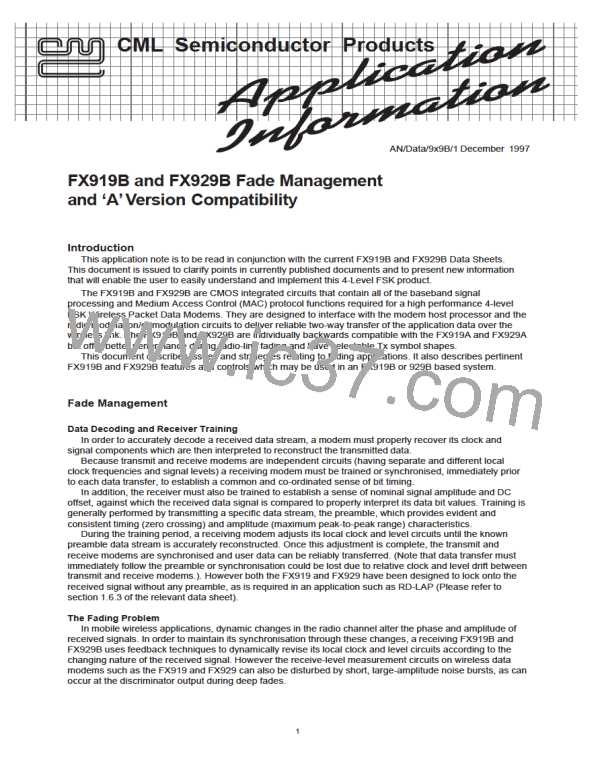Fade Management ......
Fade Management Strategies
The FX919B and FX929B devices have a new level measuring mode (Track) which allows them to ride
through most of these noise bursts, although a Data Quality monitoring algorithm has also been devised as
a last resort by re-acquiring when the receiving device appeared to have completely lost track of the input
signal.
This algorithm is detailed below and in the appropriate data sheet, and is recommended for both ‘A’ and
‘B’ versions of these devices to catch the occasional loss of level measurement tracking, which may be
caused by exceptionally long and large noise bursts.
Received Signal Quality Monitor
In applications where the modem has to monitor a long transmission containing a number of
concatenated frames, it is recommended that the controlling software includes a function which regularly
checks that the modem is still receiving a good data signal, and triggers a re-acquisition and possibly
changes to another channel if a problem is encountered. This strategy has been shown to improve the
system’s overall performance in situations where fading, large noise bursts, severe co-channel interference
or loss of the received signal for long periods are likely to occur.
Such a function can be simply implemented by regularly reading the Data Quality Register, which gives a
measure of the overall quality of the received signal, as well as the current effectiveness of the modem’s
clock extraction and level measurement systems. Experience has shown that if two consecutive DQ
readings are both less than 50 then it is worth instructing the FX919 or 929B to re-acquire the received
signal levels and timing once it has been established that the received carrier level is satisfactory. This
re-acquisition should follow the normal procedure given in section 1.6.3. of the current relevant data sheet.
The intervals between Data Quality readings is not critical, but should be a minimum of 64 symbol times
except for the first reading made after triggering the AQSC and AQLEV automatic acquisition sequences,
which should be delayed for about 250 symbol times.
A suitable algorithm is illustrated below:
AQSC/AQLEV
task issued
Reset timer.
Set µC variable 'LAST_DQ' to 99
No
Note: Times are symbol times.
Timer > 250 ?
Read DQ register into
µC variable 'THIS_DQ'
No
'THIS_DQ' < 50 ?
Yes
No
'LAST_DQ' < 50 ?
Yes
Copy 'THIS_DQ' to 'LAST DQ'.
Reset Timer.
Yes
No
Re Acquire
Timer > 64 ?
2

 CMLMICRO [ CML MICROCIRCUITS ]
CMLMICRO [ CML MICROCIRCUITS ]